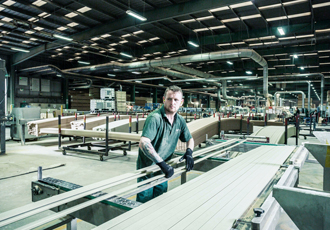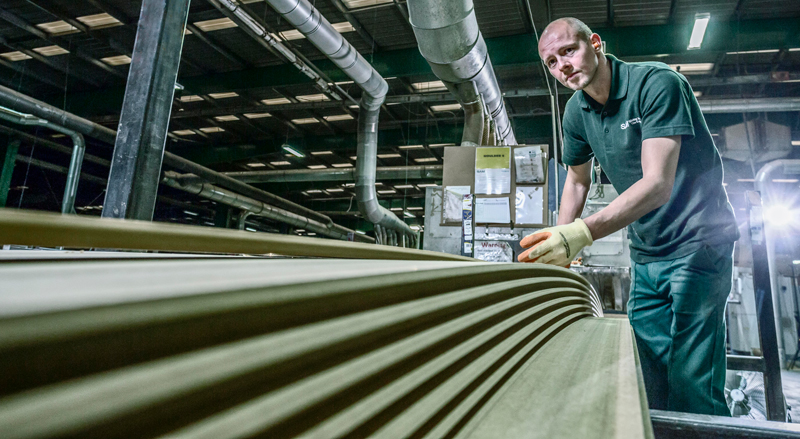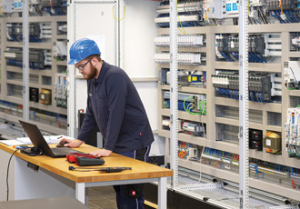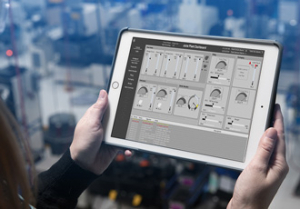Using preactor to improve system reliability and production

Siemens PLM Software solution helps Springfarm Architectural Mouldings streamline scheduling process. Springfarm Architectural Mouldings Limited (SAM) crafts moisture and fire-resistant architectural products that are free from defects and knots, do not warp and are an excellent alternative to traditional timber. The company’s range of low maintenance, cost-effective and stylish medium density fibreboard (MDF) mouldings includes skirting and architrave, door linings and casings, window components, picture frames and external cladding.
These are available in a wide variety of profile designs and sizes and are delivered in a range of finishes, from unprimed, primed, fully finished or wrapped in real wood veneer, paper or polyvinyl chloride (PVC). SAM also offers customised products, resulting in the company having 40,000 different product variants.
A family-owned business founded in 1990, SAM supplies construction companies with bulk orders and serves the home improvement market through retail outlets. The company sells millions of meters of skirting and architrave each year, and every week between 20 to 30 truckloads leave its manufacturing and distribution facility in Antrim, north of Belfast, Northern Ireland, United Kingdom, where over 150 employees work in three shifts.
The competitive challenge to deliver quickly
“Our business challenge is that 80% of customers are on the UK mainland. We also have customers in continental Europe and have supplied customers in the US,” said Tim Patton, information communications technology (ICT) director, SAM. “We therefore need to be speedy and efficient in shipping products.” Since 2005, the company has been using Preactor from the Siemens PLM Software Manufacturing Operations Management (MOM) portfolio of solutions to schedule an array of saws, moulders, paint lines and profile wrappers.
Raw materials arrive at the factory daily with trucks leaving for specific destinations. SAM holds a core range of stock and balances customer priorities with delivery schedules and competing jobs so raw materials can be turned over daily. To achieve maximum efficiency, the company must manage a range of machines that work at different speeds, ensuring that all products meet their deadlines.
“We could not schedule the factory without Preactor,” said Patton. “It understands each process and the constraints of each machine and puts each job on the planning board in the most efficient order.”

Scheduling with clarity and control
By 2015, SAM automated 40% of its scheduling and had a well-established link with its enterprise resource planning (ERP) system. “We were very happy users but over time, some issues arose as the company grew and our needs evolved and production became more complex,” commented Patton.
The system became unstable, occasionally crashing overnight because of the way in which communications from the machines in the factory were processed one by one, creating a huge bottleneck. Because there was no down-time between shifts and the schedulers were extremely busy between 4am and 7am, the possibility of a system crash was a huge concern.
“There is no system that can achieve a perfect schedule at the push of a button,” said Patton. “Much depends on the machines in use and the skill of their operators. On the moulder, for example, one person feeds the machine and one catches the product as it emerges. The paint line process involves specific sequences of sanding, painting and packing according to the job. A scheduler must be able to respond to real-world scenarios and work around unexpected machine downtime as well as planned maintenance. We wanted more flexibility for schedulers to intervene manually so that we could gain an additional 15% throughput.”
Strengthening stability, expanding flexibility and minimising waste
SAM had to address stability and the addition of intervention tools that would allow schedulers to go into the system and manipulate data. Kudos Solutions, a Siemens PLM Software partner that originally supplied the software, assisted with an upgrade to Preactor APS 400, spending two weeks onsite and writing customised code that collects data from the shop floor.
“The upgrade to Preactor APS 400 gave us a massive improvement, we are now well over our target of 75% automated scheduling,” said Patton. “The system is more reliable, it can handle more volume and support calls have reduced drastically.”
Optimising scheduling became much easier for the three master schedulers, and the new code created by Kudos Solutions created a route of communication with machine operators, who gained greater visibility, a more efficient process and better support. Each machine operator follows the master schedules that are released at 7am for the day shift and 7pm for the night shift. When a job is complete, the operator enters information, which is fed back to the master scheduler in the office who then has a clear view on whether each of the
26 machines in the factory is ahead of or behind schedule.
To avoid non-productive machine setup time, Preactor is used to group similar activities and short runs of the same thickness or width of material. In this way, Preactor APS has enabled SAM to reduce machine setup time by an additional five percent. Preactor APS also helps SAM minimise waste by managing the way in which cuts are made, re-using trimmed boards and enabling schedulers to intervene manually when necessary.
Optimising productivity
Preactor is the source of all production information. It tells the procurement manager the type and amount of raw material to order each week and is used by the logistics department for booking trucks according to the weight and volume of manufactured products moving through the factory.
Members of the senior management team meet every Monday and rely on critical data supplied by Preactor to review the previous week’s performance. Key metrics include cubic meters produced for each machine and for the factory as a whole, as well as the total number of meters manufactured. The software is also used to report on the cubic meters per 1,000 hours of operating time, machine utilisation, total setup time per machine and engineering and fault down- time. All of this data can be measured by shift and week for further review.
“All of these metrics have targets set at the start of the year, and from the results we can see on a shift-by-shift basis how the factory is performing,” said Patton. “The information we obtain from Preactor contributes significantly to decision making. For example, we are now in the process of reorganising our factory to reduce the number of machines and job setups and can now focus on longer production runs.”
Planning for the future
In December 2016, SAM acquired one of its competitors, Select Timber, with the intent of adding an additional manufacturing base in England with easy access to the London market. The new challenge for SAM will be to use Preactor to plan an integrated schedule across both sites.
“We are also looking at capacity planning,” said Patton. “Our ERP system feeds Preactor, but we lack visibility between 7am and 7pm, so we want to use Preactor for MRP. We are also considering 24-hour, real-time scheduling. We spend a lot of time on producing a very good schedule and we rely on Preactor to effectively manage the schedule and provide important feedback throughout the day.”
Similar articles
More from Siemens
- Digital Twin car game drives next-gen towards engineering 23rd March 2021
- Young engineers used talent and digital tools to make history 22nd July 2020
- Siemens at forefront of recruiting women into manufacturing 24th June 2020
- Siemens’ MindSphere helps Hosokawa Micron connect its digital factory 15th June 2020




 technology at Jacobs Vehicle Systems.JPG)







Write a comment
No comments